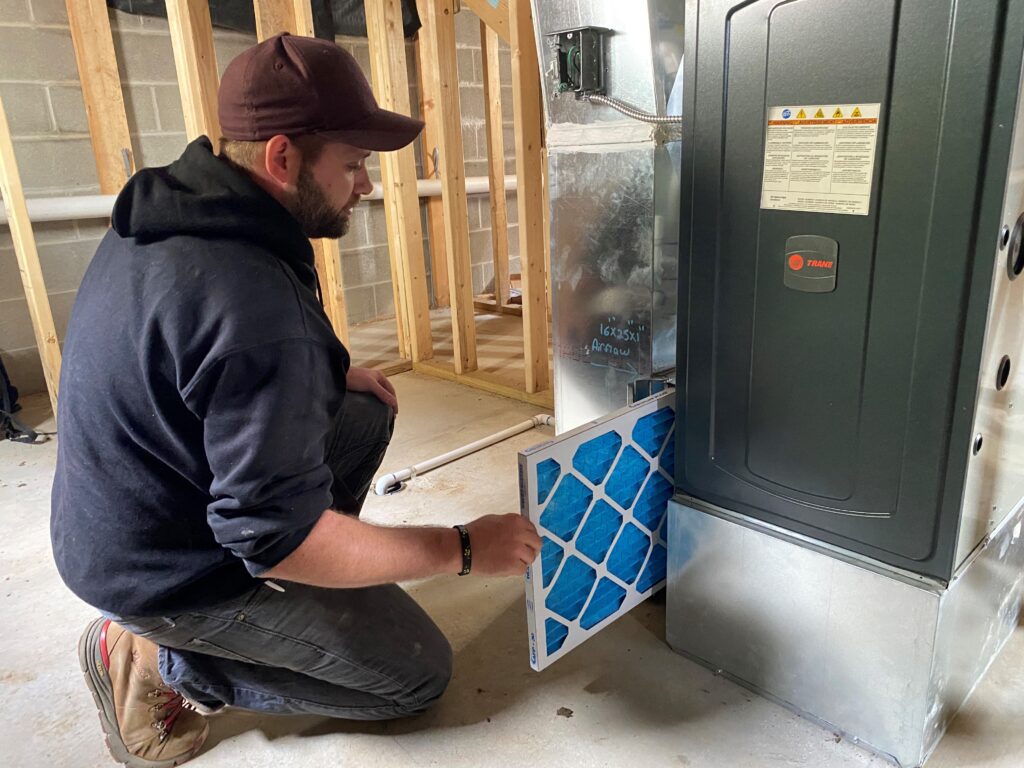Choosing the correct size furnace filter is critical yet often overlooked. Selecting an improperly sized air filter significantly reduces furnace efficiency and performance. Outsized filters allow air to bypass completely, while undersized ones restrict airflow leading to insufficient circulation, equipment strain, and potential freezing. They also require far more frequent replacement, which increases costs.
With furnace filters in a range of standard sizes, it’s essential to understand what dimensions properly fit your HVAC system based on specifications to ensure strong airflow, better filtration, optimized energy usage, and long-term furnace health. We’ll cover measuring existing filters, sizing guidelines, and recommended change frequency.
Furnace Air Filter Sizes
Selecting the properly sized furnace filter ensures good airflow and maximizes HVAC system efficiency. Furnace filters come in a range of standard sizes to match different units. Getting the right physical dimensions makes all the difference in performance.
There are two main classifications of furnace filter types—standard and high-efficiency. Standard 1-inch air filters, such as pleated air filters, are the most common and fit most residential furnace systems. High-efficiency pleated filters have more surface area for higher MERV ratings to capture more particles but need sufficient airflow. Within these furnace filter types lie the critical filter sizes:
Standard Furnace Filter Sizes:
- 16x20x1
- 16x25x1
- 20x20x1
- 20x25x1
These standard rectangular sizes have an overall depth of 1 inch and pair with typical home HVAC systems for models produced from the 1980s through today. The dimensions allow the filters to slide snugly into filter racks to prevent air bypass around the frame rather than filtering through the media.
High-Efficiency Perfect Air Plus Filter Sizes:
- 14×20
- 14×25
- 16×20
- 16×25
- 20×20
- 20×25
These deeper, extended surface variants work in the Perfect Air Plus Electronic Air Cleaner system. Again, the increased pleat depth improves particle capturing while maintaining sufficient airflow when matched properly to the HVAC unit.
Getting the actual sizes of the furnace filters in length, width, and depth ensures proper fit with a tight seal to prevent air leaks and bypass. This optimizes contact time and filtration while maintaining rated airflow across the blower motor.
Check your owner’s manual or measure the existing filter for specific sizing to maximize the benefits of proper furnace filter fit. Selecting the same size or consulting an HVAC professional before changing dimensions safeguards efficiency.
To find your proper fit, read our guide on choosing the right furnace filters.
Measuring Your Furnace Filter Size
Knowing the exact dimensions of your current furnace filter is key to choosing the best replacement size. While manufactured guidelines provide general ranges, physically measuring ensures you pick the right specifics for your HVAC model. Hiring an HVAC professional to measure and replace furnace filters is always recommended for safety and accuracy, but do-it-yourselfers can complete the task at home if preferred.
Follow these tips to measure filter size:
- Locate Existing Filter: Find your current filter, typically accessed through a door panel near the blower motor section. Remove it from the unit to measure properly when not in use.
- Check Furnace Manual: Your owner’s guide often indicates required filter dimensions or acceptable size variants for your system. Have manual specifications on hand for comparison.
- Measure Dimensions: Use a tape measure to carefully record the filter’s length, width, and depth in inches. Include both the filter media and full frame dimensions.
- Note Air Flow Direction: Filters have a specified airflow direction; make sure to insert the new one properly aligned. Arrows on the frame indicate which way it installs.
- Match Size or Consult Professional: Replace with the same measured filter size for guaranteed fit. If altering dimensions, consult an HVAC technician first to ensure the new size will properly fit your specific HVAC system.
Having accurate existing furnace filter measurements allows comparison to any new options under consideration. This prevents both undersized filters that could restrict airflow as well as oversized variants that lead to bypass and leaks. If accessing and removing your furnace filter to measure it proves challenging, it’s considered best practice to contact an HVAC technician rather than guessing at potential replacement sizes.
Matching MERV Ratings to Filter Size
Understanding the basics of MERV ratings allows you to properly tailor furnace filter performance to your HVAC system’s airflow capacity.
Key points about MERV ratings:
- MERV = “Minimum Efficiency Reporting Value,” rates filter effectiveness at capturing particles
- Higher MERV scores trap more contaminants like dust and allergens
- Increased density also causes more air resistance restricting the flow
- MERV scale runs 1-16+, higher numbers mean better particle removal
- MERV 8 captures 85% of particles over 3 microns
- MERV 11 traps 90% of particles down to 1 micron
Checking the technical specifications listed in the owner’s manual for your specific furnace blower motor provides custom insight into the best MERV rating range to match your system’s airflow capacity. As a general rule of thumb, prioritize MERV ratings around 11 that balance enhanced particle removal with minimal airflow restriction through properly sized filters.
An HVAC professional can evaluate your blower motor features and advise on the ideal MERV rating fit.
Replacement Frequency by Size Factors
Finding the optimal replacement air filter cycle minimizes costs while maintaining HVAC system performance. The most influential factors include filter size, MERV rating, home details like occupants and pets, plus seasonal variability from heating versus cooling usage. Experts recommend checking and replacing your filter every 1-3 months as a general rule, depending on the type.
- Higher MERV Ratings: Filters with elevated MERV ratings require more frequent changing—often between 1-3 months based on run times. Their increased density traps more particles but clogs faster.
- Home Size and Occupants: The more foot traffic through an HVAC system from people, pets, and activities, the faster filter buildup. Larger homes or families should replace filters more often, while smaller households may extend times closer to yearly.
- Environmental Issues: Homes with indoor smokers, pets, recent construction, or allergy issues should optimize for more filter changes to keep the air as clean as possible. Also, replace filters at the start of seasons with lower air quality, such as fall pollen or summer wildfire months, to maintain indoor air quality.
Discovering the ideal balance between filter cost, maintenance time, and performance involves noting when airflow drops or monitors show rising particle levels signaling reduced effectiveness. To learn more about the optimal frequency for filter changes, read our guide.
The Logan Difference
When selecting replacement furnace filters, rely on HVAC experts like Logan Services A/C, Heat & Plumbing for the perfect fit. Our team of certified technicians can recommend ideal sizes and MERV ratings based on your system model and airflow capacity. We proudly install and service all makes of home HVAC units and stock quality filters to precisely match even less common dimensions.
For superior filtration, ask about the proprietary Perfect Air Plus Electronic Air Cleaner, which electrically charges particles. This advanced furnace filter captures common household allergens and eliminates odors.
With over 50 years of experience installing and maintaining heating and cooling equipment in Dayton, Cincinnati, and Columbus, Logan is trusted by homeowners for all their HVAC needs. We set ourselves apart through quality workmanship and caring service.
Here’s why homeowners trust Logan Services A/C, Heat & Plumbing for furnace filter changes and HVAC support:
- Expert Technicians & Flawless Installations: Logan’s factory-trained technicians properly install your furnace to manufacturer specifications using detailed checklists and manager oversight.
- Quality Workmanship: Our “Quality Trifecta” of teamwork, communication, and commitment ensures every job meets high standards.
- Educational Experience: We take the time to walk you through your new system, address all questions, and handle warranty details so you have true peace of mind.
- Stellar Track Record: Logan is a Diamond Elite Contractor for Mitsubishi Electric and the largest volume Trane dealer in Ohio.
- Dedicated Service: As a family-owned local business, Logan provides personalized maintenance to maximize your system’s performance.
- Industry Leader: Logan’s 50+ years of experience, awards, and accreditations give homeowners confidence in their expertise.
Contact Logan A/C & Heat today—we make sure you get the right furnace filter type, understand replacement schedules, maximize HVAC system health, and breathe easier in your home. To learn more about the best furnace filters, read our guide.
Frequently Asked Questions
What size furnace filter fits my system?
Check your owner’s manual for the exact filter dimensions specified for your HVAC unit’s make and model. If unavailable, carefully remove and measure your existing filter, documenting the length, width, depth, and airflow direction before replacing it with the same size for guaranteed fit. If measuring it yourself is not feasible, consult an HVAC specialist.
Can I upgrade my furnace filter to a larger size?
It’s best not to install an oversized furnace filter without an HVAC technician’s approval, as larger filters can restrict vital airflow past the blower motor if it exceeds system capacity, reducing efficiency and straining the unit.
Should I hire an HVAC tech or DIY furnace filter replacement?
It is strongly advised to hire a certified HVAC technician for furnace filter installations and replacements rather than attempting DIY methods since improperly sized filters lead to premature system failure, wear and tear, freezing, blowing out, and other furnace damage over time.





















